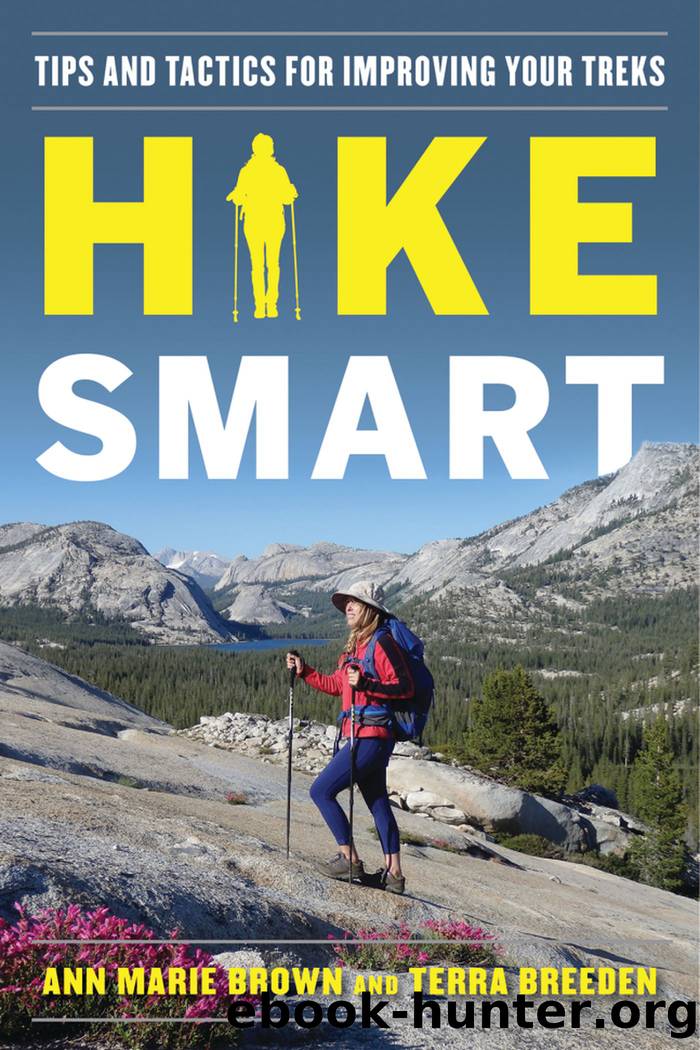Hike Smart by Ann Marie Brown

Author:Ann Marie Brown
Language: eng
Format: epub
Publisher: Skyhorse Publishing
Published: 2016-01-15T00:00:00+00:00
Boiling water is one way to eliminate giardiasis and cryptosporidiosis, but itâs not the most efficient way.
Water BottleâStyle Purifiers
Or try a slighter higher-tech solution. Water bottleâstyle purifiers, such as those made by Sawyer, Katadyn, GRAYL, or CamelBak, are as light as an empty plastic bottle and eliminate the need to carry both a filter and a bottle. You simply dip the bottle in the stream, screw on the top (which has a filter inside it), and squeeze the bottle to drink. The water is filtered on its way out of the squeeze top and into your mouth.
Sawyer makes two models, the Squeeze and the Mini, which are particularly clever. They come with three collapsible bag-like bottles of different sizes, so you save on the bulk of carrying a Nalgene or other water bottle. The Sawyer Squeeze and the Mini are simple to use, long lasting, small, lightweight, and affordable at $25 to $50. The Mini weighs only 1.8 ounces for the filter and a collapsible bag bottle, and so has become a favorite of ultralight backpackers.
The upsides to these water bottleâstyle purifiers are easy to see. There are a couple of downsides, though. If you donât screw the top on properly, or if unfiltered lake or stream water drips down the sides of the bottle and into your mouth, you could still get sick. Also, youâre only filtering one bottle at a time, which may be fine for day-hiking when you need a quick drink, but itâs nowhere near enough water for backpacking when you need a lot of water to cook dinner for a group.
Ultraviolet Light Filters: the SteriPEN
So consider the next step up in the high-tech world of water safety. It will cost you about $100, but many hikers, including us, swear by a contraption called SteriPEN, which uses ultraviolet light rays instead of chemicals to purify water. Itâs small, light, runs on batteries, and purifies thirty-two ounces of water in about ninety seconds. You hold the handle, press the âonâ button, insert the lightbulb in the neck of your water bottle, swirl it around, and voiláâyou have water thatâs safe to drink.
A few important considerations with the SteriPEN: you need to make sure you carry a wide-mouth water bottle so the lightbulb will fit inside the neck. Most hikers use these anyway, so thatâs probably not a big deal. But what could be a very big deal is that the SteriPEN runs on batteries, and as we all know, batteries seem to die when we need them most. So always carry spare batteries for your SteriPEN. And yes, batteries are heavy, so figure on a few ounces of total extra weight with the SteriPEN and an extra set of batteries. Is it worth it for easy access to clean water? We think so.
The only other part that may go kaput on the SteriPEN is the bulb or lamp, which is intended to last for 10,000 uses. Ann Marieâs died one day when she was on a simple day-hike, but fortunately she was hiking with someone else who also had a StreriPEN.
Download
This site does not store any files on its server. We only index and link to content provided by other sites. Please contact the content providers to delete copyright contents if any and email us, we'll remove relevant links or contents immediately.
Annapurna by Maurice Herzog(3403)
Liar's Poker by Michael Lewis(3330)
A Forest Journey by John Perlin(3012)
Atlas Obscura by Joshua Foer(2769)
The Ogre by Doug Scott(2606)
Cuba by Lonely Planet(2533)
Photographic Guide to the Birds of Indonesia by Strange Morten;(2469)
Tokyo by Rob Goss(2348)
All Things Reconsidered by Bill Thompson III(2333)
The Splendid and the Vile by Erik Larson(2309)
A TIME OF GIFTS by Patrick Leigh Fermor(2136)
INTO THE WILD by Jon Krakauer(2135)
Fatal Storm by Rob Mundle(2114)
Trail Magic by Trevelyan Quest Edwards & Hazel Edwards(2109)
DK Eyewitness Top 10 Travel Guides Orlando by DK(2082)
Top 10 Dubai and Abu Dhabi by DK Travel(2035)
Abbey in America by Murray John A(2032)
Touching the Void by Joe Simpson(2024)
Lonely Planet Australia by Lonely Planet(2010)
